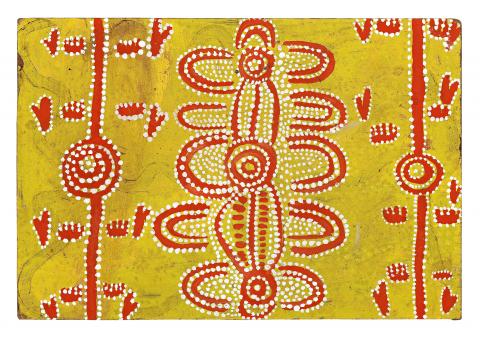MALA (RUFOUS HARE WALLABY) DREAMING, 1971
JOHNNY WARANGKULA TJUPURRULA
synthetic polymer powder paint on composition board
23.0 x 34.5 cm
Painted at Papunya in 1971
Geoffrey Bardon, New South Wales
Private collection, New South Wales
Deutscher~Menzies, Melbourne, 10 August 1998, lot 13
Private collection, Melbourne
Sotheby's, Melbourne, 26 July 2004, lot 91
Private collection, Melbourne
Tjukurrtjanu: Origins of Western Desert Art, The Ian Potter Centre, National Gallery of Victoria, Melbourne, 30 September 2011 – 12 February 2012; Musée du Quai Branly, Paris, 9 October 2012 – 27 January 2013 (label verso)
Mala, the Rufous Hare Wallaby (Lagorchestes hirsutus) was once a distinctive inhabitant of the Western Desert, where the hare-sized animal sheltered in needle-sharp tussocks of mature spinifex. Fire was used to promote a mosaic of vegetation types, on which the wallabies were dependent, and fire was again deployed by the Pintupi to flush Mala from cover, so hunters could dispatch the wallabies as they fled.1
Johnny Warangula was intimately associated with the Mala ancestors. He inherited custodianship of the Dreaming from his father and grandfather, who were born at Tjikarri, a rocky outcrop in the heart of Mala country, east of Wilkinkarra (Lake MacKay). There are two distinct narratives associated with Tjikarri: one involves the Nananana men hunting Mala with fire (in the fashion outlined above), while the other concerns the journey of an old sorcerer, Lurnpa, the Red-backed Kingfisher (Todiramphus pyrrhopygius), who, with the aid of a Mala horde, pursues a giant dingo-like creature, Matinpilangu. 1
Geoffrey Bardon verified that Mala (Rufous Hare Wallaby) Dreaming is Warangula’s first painting, created in the Western Desert idiom at Papunya in 1971. Moreover, he confirmed that the painting depicts the Mala Dreaming at Tjikarri.2 Produced before Warangula developed his characteristic over-dotting style, the current painting provides an iconographic representation of ceremonial ground and the movements of performers as they reenact the deeds of the Mala ancestors. The central motif provides a planar view of the ceremonial area, with figures (U-shapes) seated around an attenuated performance area. The tracks of Mala ancestors are described on either side of the motif, moving from the bottom to the top of the board. Instrumentally, the tracks on either side of the central motif are subtly different. 1
The leftmost track shows a Mala ancestor moving slowly, dragging its tail (straight line) and using its front paws (E-shapes) for support, as it lifts its large rear legs in the typical mode of Australian macropods (as indicated by V-shaped footprints). The movement of the Mala ancestor on the right is more distinct. As the animal approaches the concentric circle, it rests one clenched paw on the ground, (to look around?), then placing both front paws on the earth on the rim of the roundel (as if to drink). The Mala then hops over the circle, resting its front right paw on the ground again (to check the scene?) before continuing. In the ceremonial context, elaborately decorated performers re-enact the actions of the Mala ancestors. 1
The hardboard, which supports the Mala (Rufous Hare Wallaby) Dreaming, is made of salvaged materials used in the first months of painting at Papunya. The board’s familiar materiality is enhanced by the presence of a previous painting, evident below the yellow ochre background. The excitement that came with the revelation of distant sites and ceremonies is palpable in the directness of Warangula’s attack. 1
1. While they were widespread in Warangula’s youth, Mala are now extinct in mainland Australia, having been adversely affected by changes to the fire regime in combination with depredation by introduced animals, notably the Red Fox. The last mainland Mala was sighted in the Tanami Desert in 1991.
2. Geoffrey Bardon, ‘Lot 13’, in Fine Art Paintings, 10 August 1998, Melbourne, Deutscher-Menzies, p. 24. 1
JOHN KEAN
